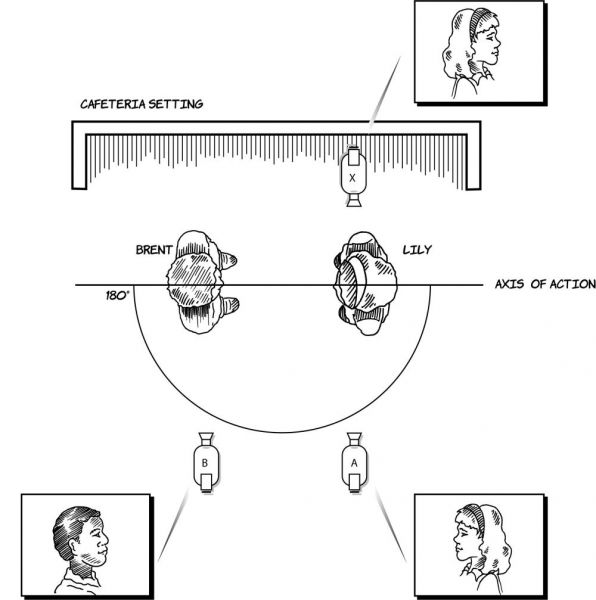Difference between revisions of "JCM312/Editing"
From Screenpedia
Jump to navigationJump to search| (20 intermediate revisions by 2 users not shown) | |||
| Line 1: | Line 1: | ||
| − | == | + | <gallery mode="packed" heights=400px> |
| − | + | File:Fig09-05 180 Degree.jpg|alt=180-Degree Diagram from ''Television''.|180-Degree Diagram. | |
| − | + | </gallery> | |
| − | |||
| − | |||
| − | |||
| − | |||
| − | |||
| − | #''' | + | ==Scene découpage== |
| − | #''' | + | #''Television'' discusses the editing of [http://tvcrit.com/find/greysanatomy this scene from ''Grey's Anatomy''], breaking it down in what the book calls a découpage. |
| − | #*What is its purpose | + | #*We can create a [https://tvcrit.org/EO/DV/FilmArt/OutOfSightStills/index.htm similar découpage of a scene] from Steven Soderbergh's ''Out of Sight'', featuring Jack Foley (George Clooney) and Karen Sisco (Jennifer Lopez). Using this découpage, draw an overhead diagram of the camera positions of all eight shots--similar to the 180-degree diagram above. (Draw just ''one'' diagram that shows ''all'' the camera and actor positions.) |
| − | # | + | #*Does this scene use the editing conventions listed below? Be specific. Hint: be sure to look closely at the first shot. It's a reflection in the window! |
| − | # | + | ##The 180-degree rule. ([http://tvcrit.com/find/180degreerule Peter John Ross's example]) |
| − | # | + | ##*Where does it get its name? |
| − | # | + | ##*What is its purpose? |
| − | # | + | ##Establishing shot and re-establishing shot |
| − | # | + | ##Shot/reverse-shot (sometimes called "shot/counter-shot") |
| − | # | + | ##Match cuts: |
| − | + | ##*Eyeline match | |
| + | ##*Match on action | ||
| + | ##Jump cut | ||
| − | == | + | ==External links== |
| − | #'' | + | #[https://tvcrit.org/Classes/Jbutler/TVCrit2018_images_ByChapters/10/ ''Television'', editing chapter] |
| − | + | #[https://tvcrit.org/Classes/Jbutler/T340/ClassicismIllustrations01.htm Classical Hollywood editing examples] | |
| + | #[https://tvcrit.org/EO/DV/FilmArt/index02.htm ''Film Art'' examples] | ||
| + | #[https://tvcrit.org/EO/DV/FilmArt/OutOfSightStills/index.htm ''Out of Sight'' découpage] | ||
== Bibliography == | == Bibliography == | ||
| − | #Jeremy G. Butler, ''Television: | + | #Jeremy G. Butler, ''Television: Visual Storytelling and Screen Culture'' (New York: Routledge, 2018). |
#David Bordwell and Kristin Thompson, ''Film Art: An Introduction'' (New York: McGraw-Hill). | #David Bordwell and Kristin Thompson, ''Film Art: An Introduction'' (New York: McGraw-Hill). | ||
| − | + | [[Category:JCM312 Discussion]] | |
| − | |||
| − | |||
| − | |||
| − | |||
| − | [[Category: | ||
Latest revision as of 19:11, 4 September 2019
Scene découpage
- Television discusses the editing of this scene from Grey's Anatomy, breaking it down in what the book calls a découpage.
- We can create a similar découpage of a scene from Steven Soderbergh's Out of Sight, featuring Jack Foley (George Clooney) and Karen Sisco (Jennifer Lopez). Using this découpage, draw an overhead diagram of the camera positions of all eight shots--similar to the 180-degree diagram above. (Draw just one diagram that shows all the camera and actor positions.)
- Does this scene use the editing conventions listed below? Be specific. Hint: be sure to look closely at the first shot. It's a reflection in the window!
- The 180-degree rule. (Peter John Ross's example)
- Where does it get its name?
- What is its purpose?
- Establishing shot and re-establishing shot
- Shot/reverse-shot (sometimes called "shot/counter-shot")
- Match cuts:
- Eyeline match
- Match on action
- Jump cut
External links
- Television, editing chapter
- Classical Hollywood editing examples
- Film Art examples
- Out of Sight découpage
Bibliography
- Jeremy G. Butler, Television: Visual Storytelling and Screen Culture (New York: Routledge, 2018).
- David Bordwell and Kristin Thompson, Film Art: An Introduction (New York: McGraw-Hill).
